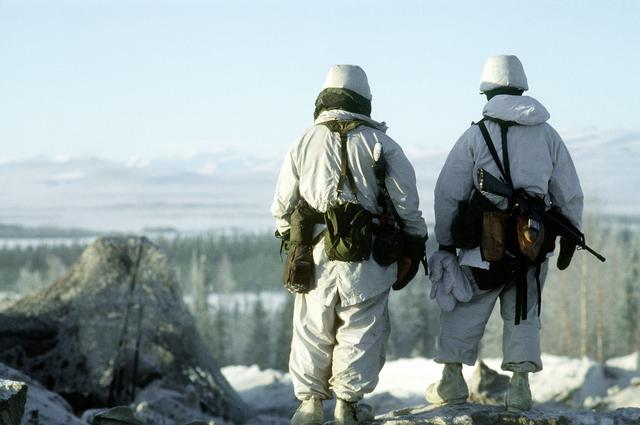VAERNES GARRISON, Norway — A hump through the snow-covered sub-freezing moonscape of the Arctic is the wrong time to find out your boots won’t stay latched into your skis.
But that’s what happened to many troops from Bravo Company, 1st Battalion, 2nd Marines, as they completed an extended stretch of cold-weather training in Porsangermoen, nearly 1,000 miles north of their headquarters position here at Vaernes.
During this first deployment for Marine Rotational Force-Europe, troops spent weeks training and operating in gear they described as badly in need of an overhaul: inflexible zippers, seams that separated and tore, pack frames that snapped, and boots that pulled loose from ski fastenings over and over.
While none of this gear is new — it’s routinely used by Marines during mountain warfare training at Bridgeport, California, and in previous shorter cold weather exercises — it faces perhaps its most difficult test during this deployment.
One purpose of the new rotation is to allow Marines to become more accustomed to operating in the cold and snow, and the unit has done exactly that: three weeks of intensive cold-weather training under the supervision of British troops, followed by a week participating in the multilateral training exercise Joint Viking.
Anticipating that Marines from the rotation would have feedback on the gear, Marine Corps Systems Command flew in more than half a dozen program officers from the command following the three-week Arctic training period to listen to the troops’ criticisms and take notes on how to improve the equipment. They may not have been prepared, however, for the passionate response that greeted them.
“That was an emotional experience for many people,” said 1st Lt. Sean Gil, commanding officer of Bravo Company’s 3rd Platoon. “The unit had just gotten off of almost continuous field operations, suffering because of, maybe, certain shortcomings in the gear, and they felt like taking it out on the evaluators. I would say we definitely had feedback for them.”
New Gear Planned
According to officials at Marine Corps Systems Command, some of the gear that is standard-issue for Marines operating in the cold was already set to be modified or replaced prior to the deployment, and other items may be changed based on evaluation data provided by the deployed troops.
The command is working to update the All Purpose Environmental Clothing System, or APECS, parka and trousers with secondary closures and more durable zippers to provide redundant closure systems, SYSCOM spokeswoman Barb Hamby told Military.com.
The jacket’s zippers tended to rip at the seams when Marines attempted to add more warm layers the way they had been taught, said Staff Sgt. Nelson Acevedo, platoon sergeant for Bravo Company’s 3rd Platoon. In the cold, Marines were instructed to zip down their jackets only three-quarters of the way and slide it off their shoulders in order to add a warming layer underneath, minimizing exposure to the cold and the time spent making the change.
“The seams were a big focal point,” he said. “They would wear and tear down pretty easily.”
Hamby said the Corps also plans to adopt gear used by the Army: the lightweight exposure suit and the Gore-Tex extreme cold weather jacket and trousers.
“Following extensive interviews and surveys with Marines in the field, an analysis of the data is being completed to determine if other modifications need to be made,” she said in a statement provided to Military.com.
The current lightweight exposure suit and extreme cold weather parka are the products of collaboration between SYSCOM and Program Executive Office-Soldier, although it’s not clear when Marines will be issued these items. Currently, Marine cold weather gear consists of a Gore-Tex overlayer and a series of base, insulating, and waterproof warming layers, which can be worn in accordance with conditions and the Marine’s preference, Hamby said.
While every Marine who spoke with Military.com had specific criticisms about the gear, the layering concept seems to work well for many.
“The warming layers and everything did fantastic,” said 1st Lt. Aidan Frombach, commanding officer for Bravo’s 2nd Platoon. “No real complaints.”
New Skis and Ski Boots
Officials also say new skis are on the way, and set to be fielded in fiscal 2018. Multiple Marines complained that their skis would not stay attached to their boots, and called the system outdated and frustrating to use.
“I wouldn’t give anybody that ski setup that we had,” said Acevedo, the platoon sergeant. “When you’re putting your boots into the bindings, because the bindings are metal and the boots are old rubber, they rip a lot. So now you’re potentially causing injuries to the individual from the cold now being able to seep through.”
The cold-weather boots are designed for static use, he added, but heavy and cumbersome when troops are trying to move and maneuver.
Staff Sgt. Troy Hauck, platoon sergeant for Bravo’s Weapons Platoon, said he had used all the Marine Corps’ cold weather gear before, as an instructor at the Mountain Warfare Training Center in Bridgeport. It was rewarding, he said, to finally be able to provide feedback and criticism on the gear in a formal way.
Recently, he said, he sat down with Lt. Gen. John Wissler, commander of Marine Corps Forces Command, and offered his insights on the various items.
“The Marine Corps needs to adopt a new set of skis — the British have good stuff — and new boots,” he said. “The boots that we currently have are not sufficient to do what we need to do. They’re good for certain things, but skiing around and mobility is not good at all … So better gear, to me, I think will help [Marines] be more proficient and be able to move better in the Arctic environment.”
Hamby indicated the Corps is aware of the mobility problem with the boots. When the new modernized military ski system is fielded, she said, Marines will no longer use the heavy extreme cold weather boot with their skis. Instead, she said, the new ski system will include a dedicated “ski march” boot.
“The extreme cold weather boot will continue to be issued to Marines for general use,” she said.
Snapping Pack Frames
Of all the gear malfunctions that have affected Marine Rotational Force-Europe troops during cold weather ops, perhaps the most common is plastic internal pack frames that become brittle and snap in the cold.
1st Lt. Bryan Duffy, the logistics officer for MRF-E, estimated he had had to order about 50 replacement packs for Marines whose issued packs failed when temperatures plummeted. But for those who had packs break in the middle of cold-weather survival training, the only option available was to improvise.
“We had to use 550 [parachute] cord and duct tape to figure it out,” Hauck said. “It was not fun.”
As Military.com reported in January, SYSCOM is in the process of developing a reinforced pack frame in response to earlier problems that arose during standard infantry training at Camp Pendleton, California, and during previous cold weather exercises in 2015 and 2016.
SYSCOM sent 40 of the packs to Marines with MRF-E when they deployed in January, with plans to take the gear back and evaluate it for damage and weaknesses after the Marines return from their rotation this summer.
Hamby said it appears the new prototypes fared much better in the cold than the issued frames.
“Initial inquiries indicate that few, if any, of the reinforced pack frames failed; however, we will not know for certain until we perform our inspections,” she said.
Maj. Gen. Niel Nelson, commanding officer of Marine Corps Forces Europe and Africa, cast the deployment as a learning opportunity for the Marine Corps, saying the service would fix the gear problems that have been identified.


